Catalogue of the
Greek, Roman, and Byzantine Weights from Ödemiş Museum
(Türkiye)
Abstract:
This article examines 28 weights from the collection of the
Ödemiş Museum, a local museum located in western Anatolia. Two
of the weights are attributed to Colophon due to the presence of
a parasemon, while two others were
produced by Ionian cities during the Roman Imperial period and
used in local markets. Some weights dated to the Hellenistic
period cannot be attributed to specific cities due to the
absence of a parasemon or ethnic, yet they
are significant for the unit marks they bear. It is clear that
the magistrate names found on some of the weights may offer
noteworthy contributions to research in this field. The
remaining weights are from the Roman and Byzantine periods and
include examples of uncia and
nomisma weights, along with their subunits.
Key words:
Ödemiş, ancient weights, Byzantine weights, Colophon, Ionia
Zusammenfassung:
Dieser Artikel behandelt 28 Gewichte aus der Sammlung des
Ödemiş-Museums, einem lokalen Museum in Westanatolien. Zwei der
Gewichte werden aufgrund eines Parasemons Kolophon zugewiesen,
zwei weitere waren von ionischen Städten während der
hellenistischen oder römischen Kaiserzeit hergestellt worden und
fanden auf lokalen Märkten Verwendung. Einige in die
hellenistische Zeit datierte Gewichte können mangels Parasemon
oder Ethnikon keiner bestimmten Stadt zugeordnet werden, sind
jedoch aufgrund ihrer Einheitszeichen von Bedeutung. Es ist
offensichtlich, dass die auf einigen Gewichten genannten
Magistratsnamen einen bemerkenswerten Beitrag zur Forschung auf
diesem Gebiet leisten können. Die übrigen Gewichte stammen aus
römischer und byzantinischer Zeit und umfassen Beispiele für
Uncia- und Nomisma-Gewichte sowie deren Untereinheiten.
Schlagwörter: Ödemiş, antike Gewichte, byzantinische Gewichte, Kolophon, Ionien
Introduction
The Ödemiş Museum is
located in the town of Ödemiş in Western Anatolia, approximately
110 kilometers southeast of İzmir. Within an hour’s drive from
the museum lie the ancient cities of Smyrna, Sardis, Colophon,
and Ephesos (Map). This article
focuses on 28 balance weights from the museum collection,
excluding a few pieces that are heavily corroded or damaged
beyond identification[1].
All of the weights entered the museum through purchase or
confiscation; none originate from archaeological excavations.
Twelve of the weights are dated to the Hellenistic period, and
two of these (nos. 1–2) are attributed to the city of
Colophon due to the presence of a lyre motif, a parasemon of the
city[2].
With the exception of a few, all Hellenistic weights bear a unit
mark, making their denominations identifiable; for those lacking
unit marks (nos. 7, 8, 11), proposed units are offered
based on their actual weights. Two weights (nos. 13–16)
were produced and used by city-states under the rule of the
Roman Empire and the remaining (nos. 17–27) belong to the
Roman and Byzantine era. Five
square Byzantine weights (nos. 19–23)
are placed immediately after the doubly truncated
flattened-sphere weights, as they are slightly earlier in date
than the disc-shaped examples (nos.
24–27). The last one (no. 28) is a
mastoid weight dated to the very end of the 1st
century AD or early Imperial period; it was placed at the
end because of its form. As expected, the
Hellenistic weights conform to the Greek standard based on the
mna, while the Imperial-period weights follow the Roman
system, which is based on the libra[3].
It is clear that the magistrate names found on some of the
weights, such as Pandok..., Menekrates, and Bagas, can provide a
noteworthy contribution. The identification, description,
comments, and dating of each weight are provided at its
respective entry in the catalogue[4].
Since the weights in the Ödemiş Museum – a local museum – were
found in the nearby area (at least, that is what the acquisition
records indicate) and brought to the museum, they are
potentially informative for the weight repertoire of the region
of Ionia.
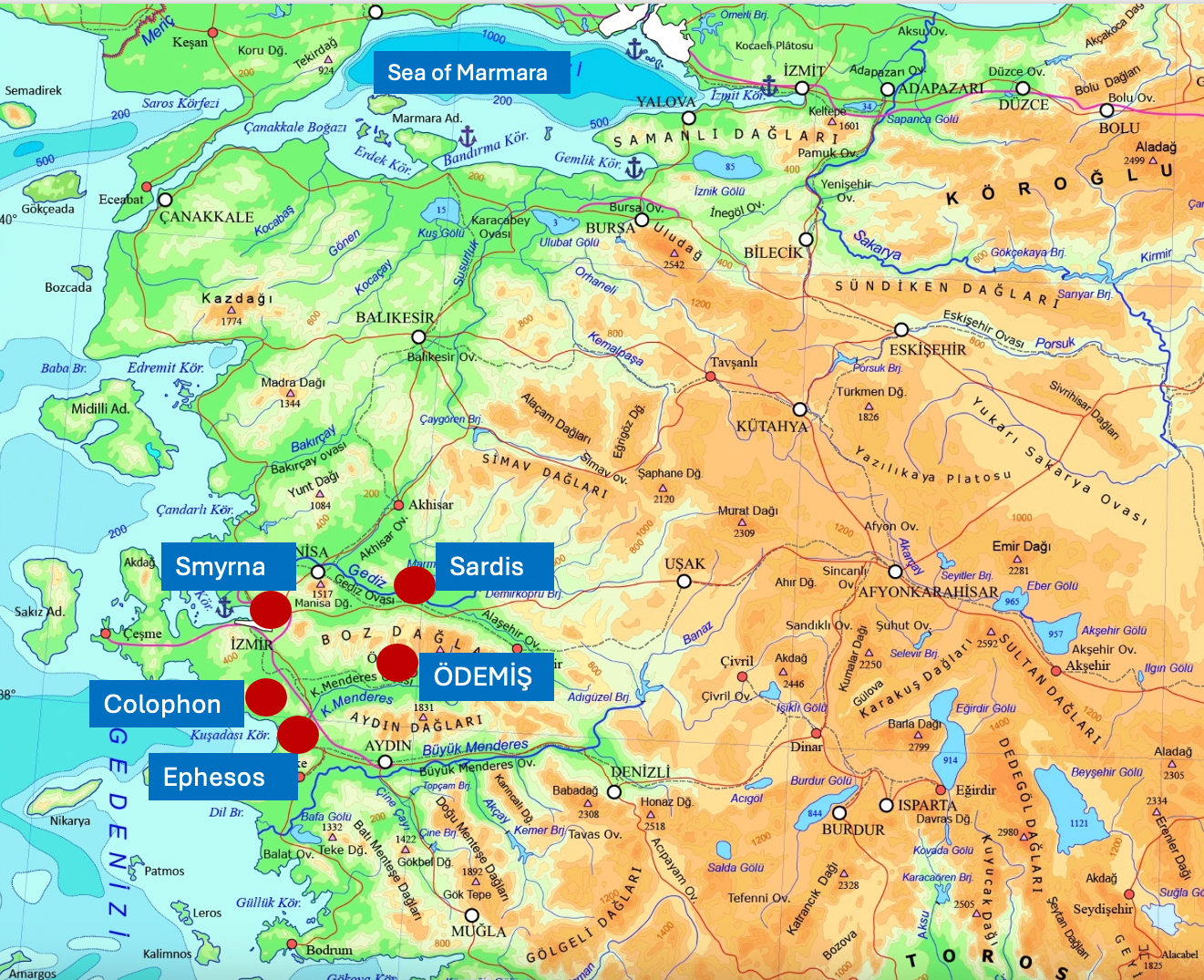
Hellenistic Weights
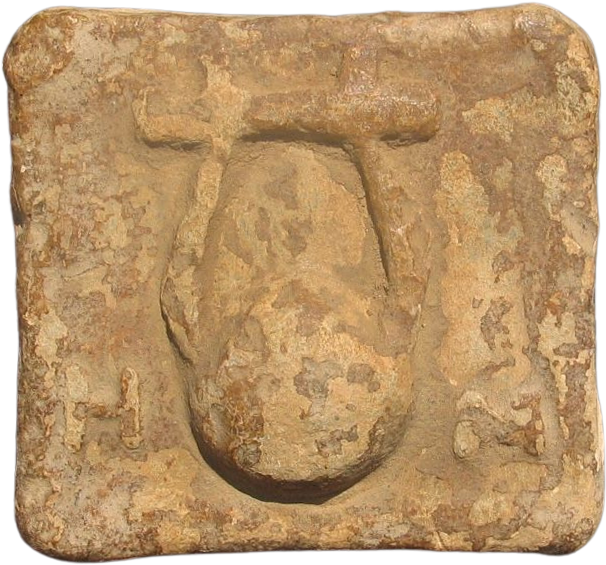
1) Inv. no. 2605
(fig. 1). Lead, 264.37 g, 61 x 53 x 9 mm.
Square in form
with plain profile but edges are slightly concave.
Colophon. ½
mna (hemimnaion, mna of 528.74 g).
On the top, lyre; on
the bottom left and right, H – M which stands for
Ἡμιμναῖον. The bottom is plain.
It
dates to the Hellenistic period. Published[5].

2) Inv. no. 2478
(fig. 2). Lead, 47. 61 g (current autopsy but during the
earlier weighing, it was 47.55 g), 22 x 24 x 10 mm.
Square in
form.
Colophon. Two staters (distateron, stater of
23.80 g).
On the top, lyre and Δ
on the bottom left corner, which stands for
Διστάτηρον;
all in relief. The bottom is plain.
It dates to the Hellenistic
period. Published[6].

3) Inv. no. 1793
(fig. 3). 159.52 g, 41 x 38 mm. 1/3 mna (triton,
mna of 478.56 g).
Square in form with slightly raised edges.
On
the top, anchor and ΤΡ
in ligature which stands for Τρίτον;
all in relief. The bottom is plain.
It dates to the Hellenistic
period. Unpublished.
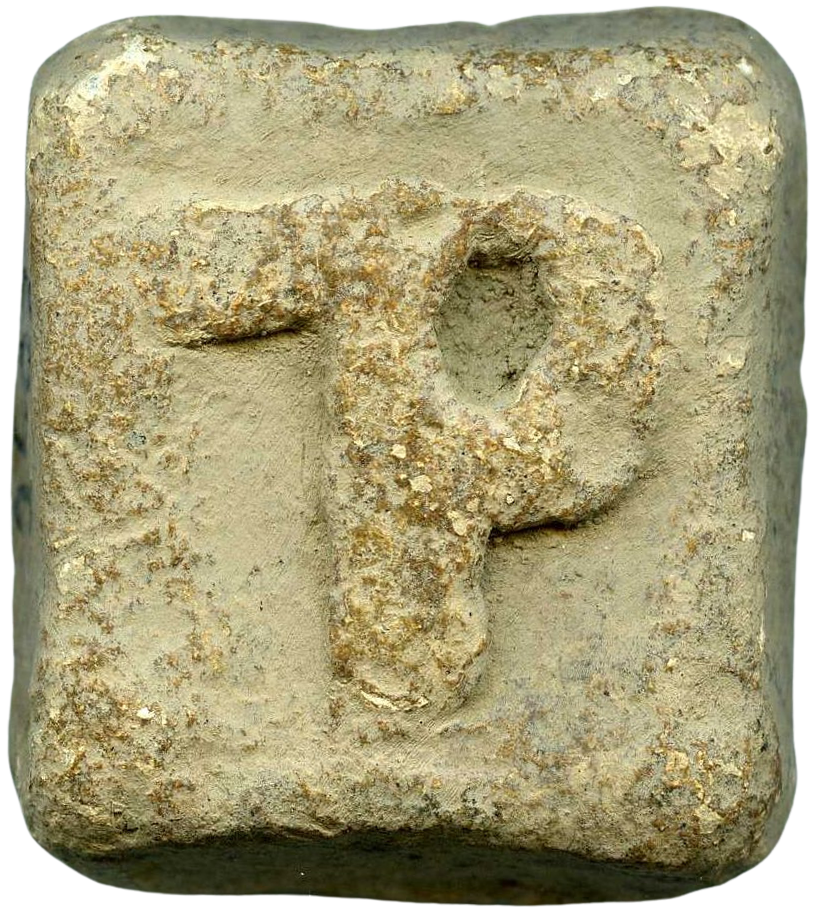
4) Inv. no. 2607
(fig. 4). Lead, 149.18 g, 38 x 35 x 13 mm. 1/3 mna (triton,
mna of 447.54 g).
Square in form with slightly raised edges and
plain profile.
On the top, ΤΡ
in ligature and in relief, which stands for Τρίτον.
The bottom is plain but deep scratch.
It dates to the
Hellenistic period. Unpublished.
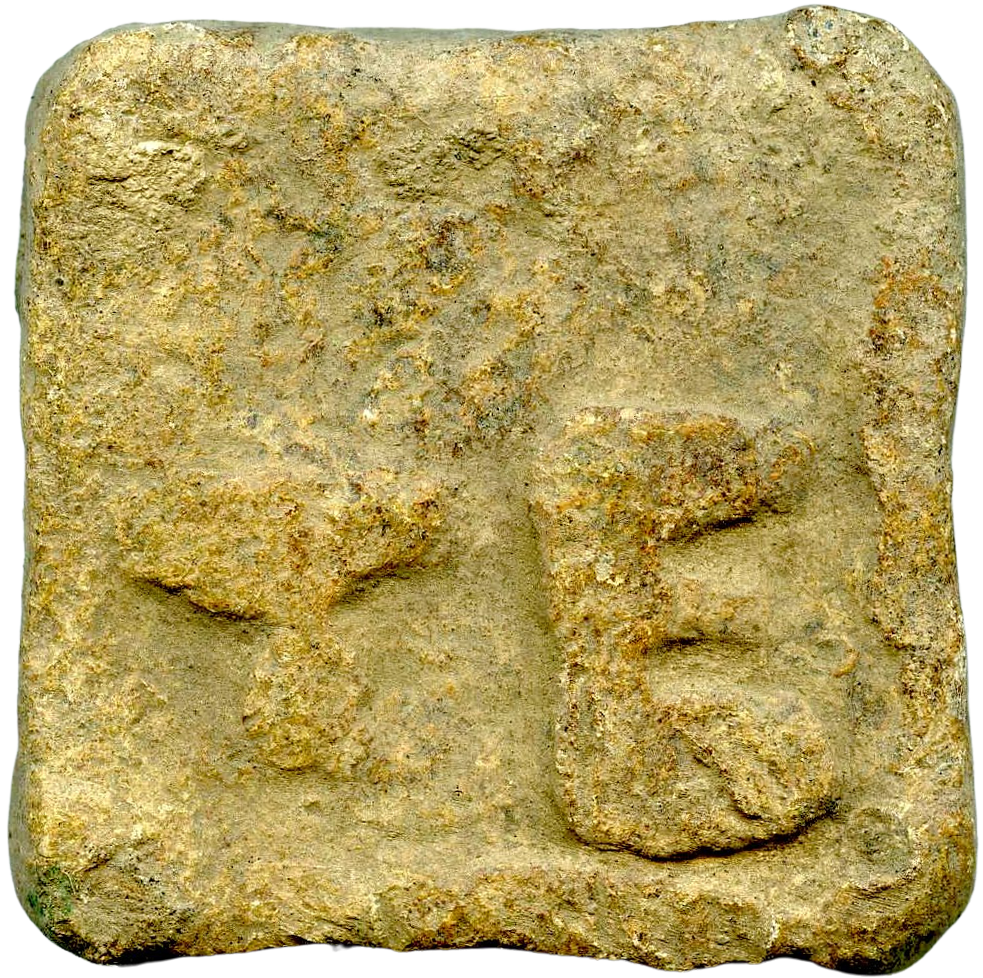
5) Inv. no. 2606
(fig. 5). Lead, 126.32 g, 42 x 42 x 9 mm. ¼ mna (tetarton,
mna of 505.28 g).
Square in form with slightly raised and
concave edges.
On the top, TE in relief which stands for
Τέταρτον. The bottom is plain.
It dates to the Hellenistic period. Unpublished.
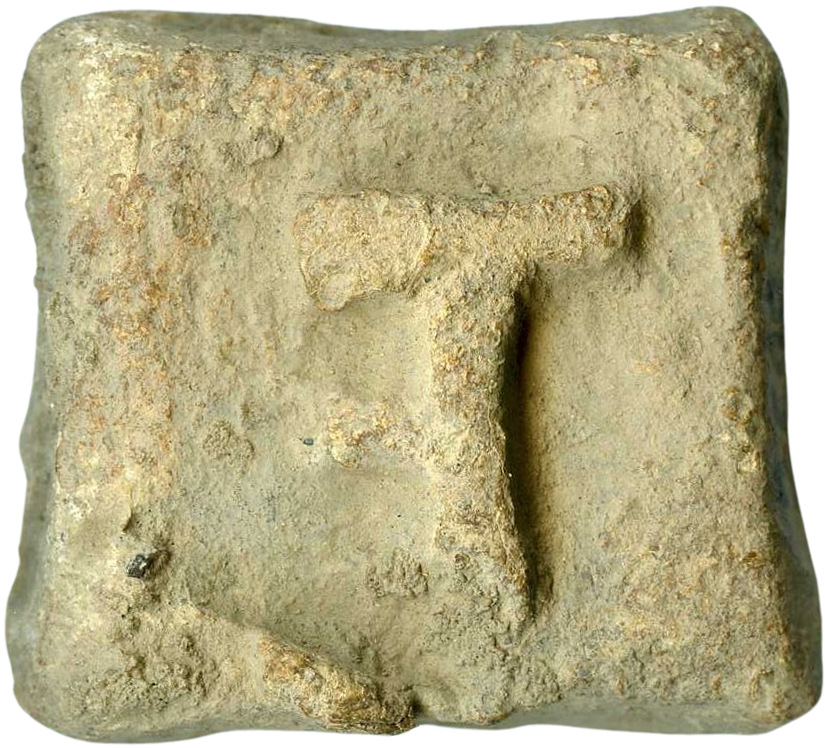
6) Inv. no. 2608
(fig. 6). Lead, 91.15 g, 32 x 34 x 9 mm. ¼ mna (tetarton,
mna of 364.6 g).
Square in form. Its weight is quite low for a
tetarton. The edges are raised on both sides.
On the top, TE in
reverted ligature and in relief, which stands for
Τέταρτον. The bottom is plain.
It
dates to the Hellenistic period. Unpublished.
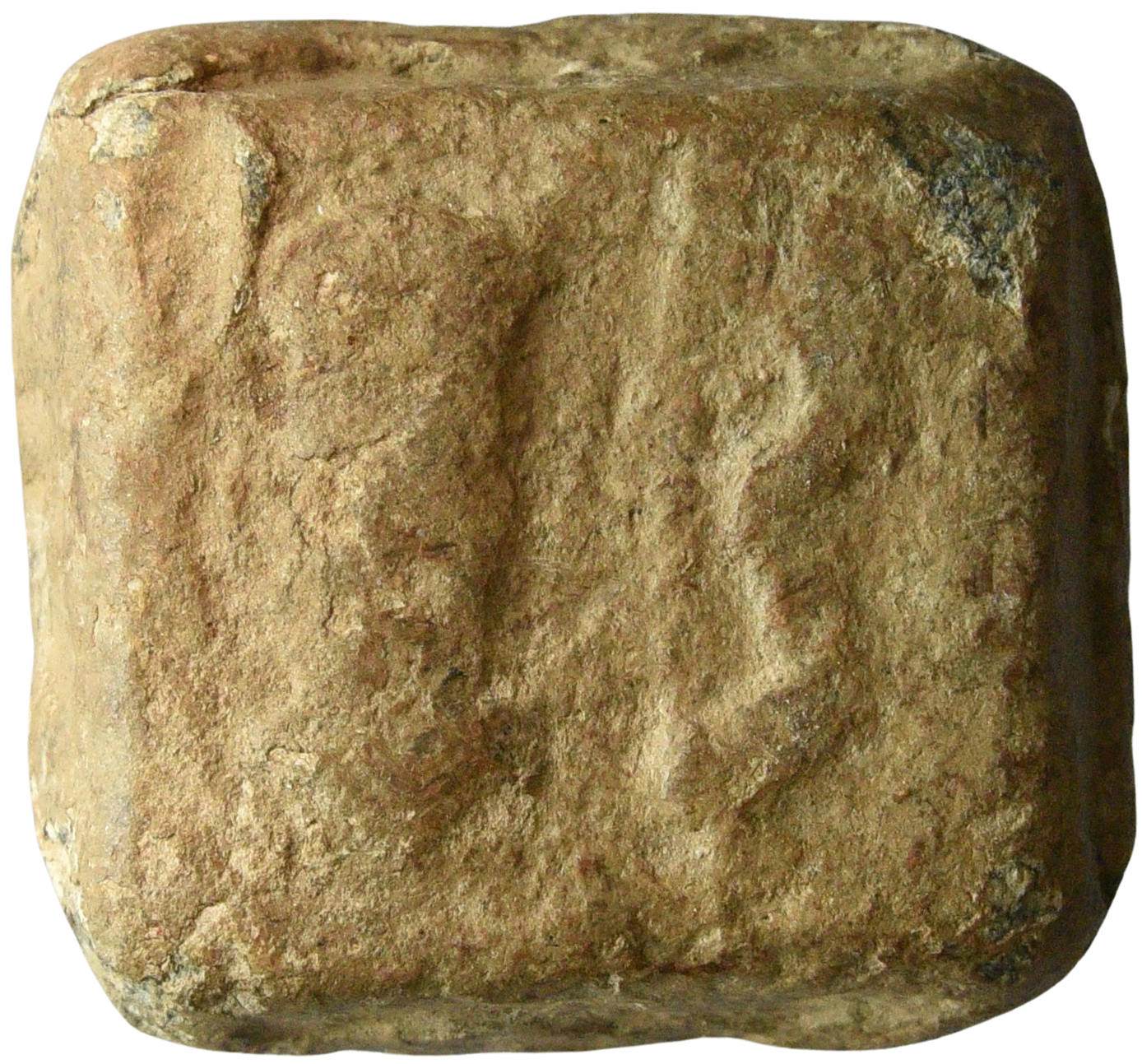
7)
Inv. no. 2001-12 (fig. 7). Lead, 99.80
g, 35 x 32 x 10 mm. 1/6 mna? (mna of 598.8 g).
Square in form
with slightly beveled edges. On the top, quiver and bow in
relief.
The denomination is not certain. The bottom is plain.
It
dates late
2nd–1st centuries BC.
Unpublished.
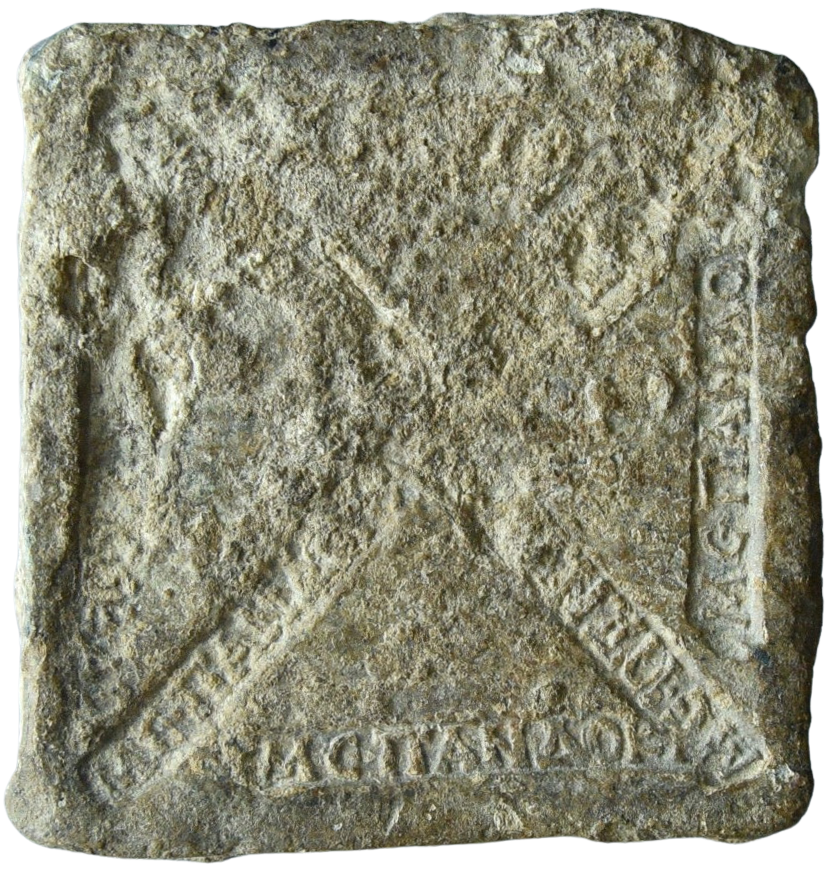
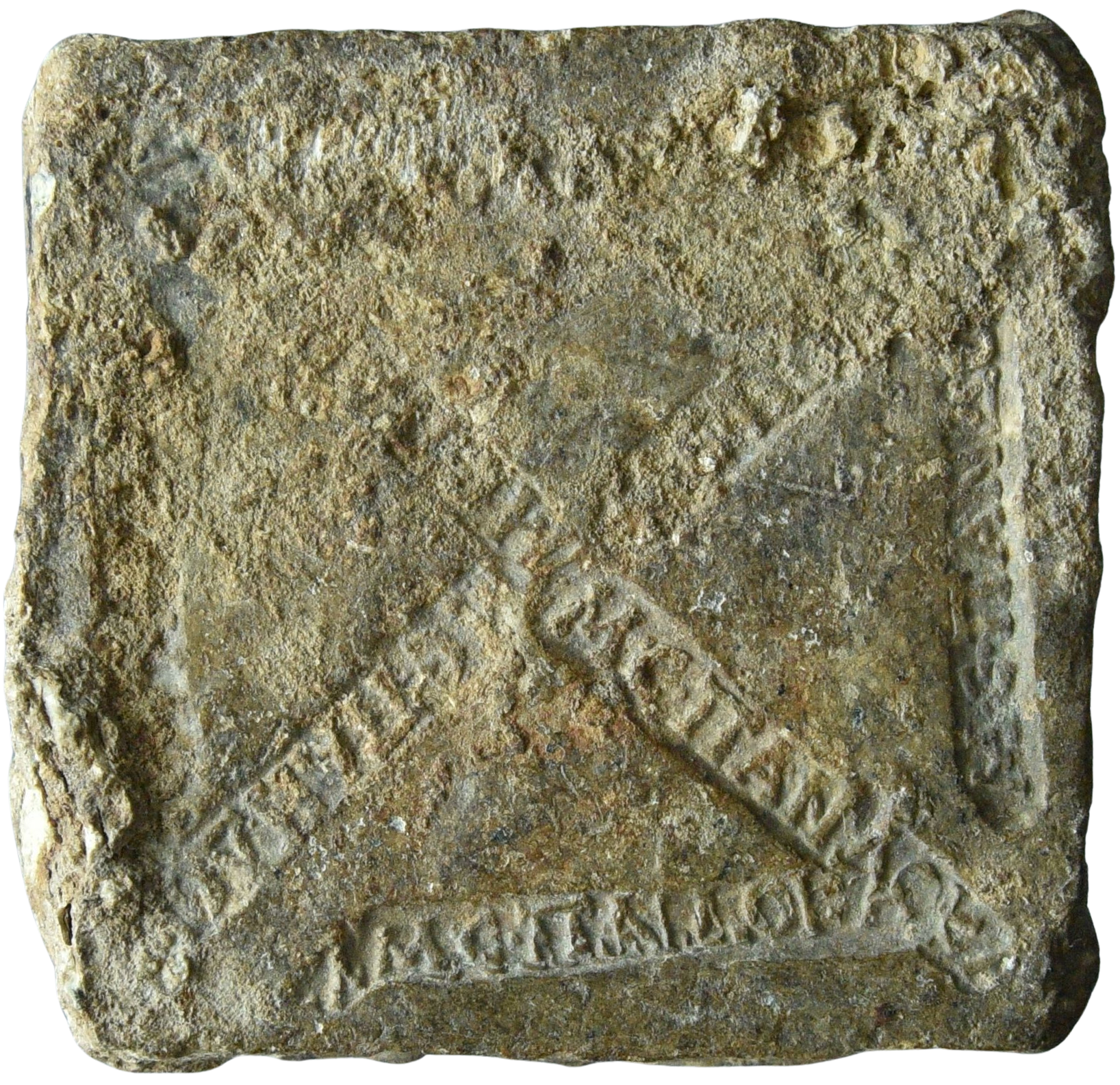
8)
Inv. no. 2474 (fig. 8).
Lead, 89.35 g, 41 x 39 x 7 mm. 1/6 mna? (mna of 536.1 g).
Square
in form.
On the top and bottom, A square composed of thick bands
enclosing an X-shaped pattern made of equally broad bands
reaching from corner to corner; the legend
ΜΕ.
ΠΑΝΔΟΚ is inscribed
within each of the bands[7].
The name may refer to a certain Pandokos but not certain[8].
The weight seems to correspond to 1/6 mna (mna of 536.1 g), but
it's not certain, too.
It dates to the Late Hellenistic period
or to the very beginning of the Roman Imperial period. This
weight was previously published by Laflı and Buora; however, the
inscription was unfortunately misread as
ΜΕΤΡΟΝ ΑΔΟΚΙ[ΔΟΥ]
and misinterpreted as measure of Andokides[9].
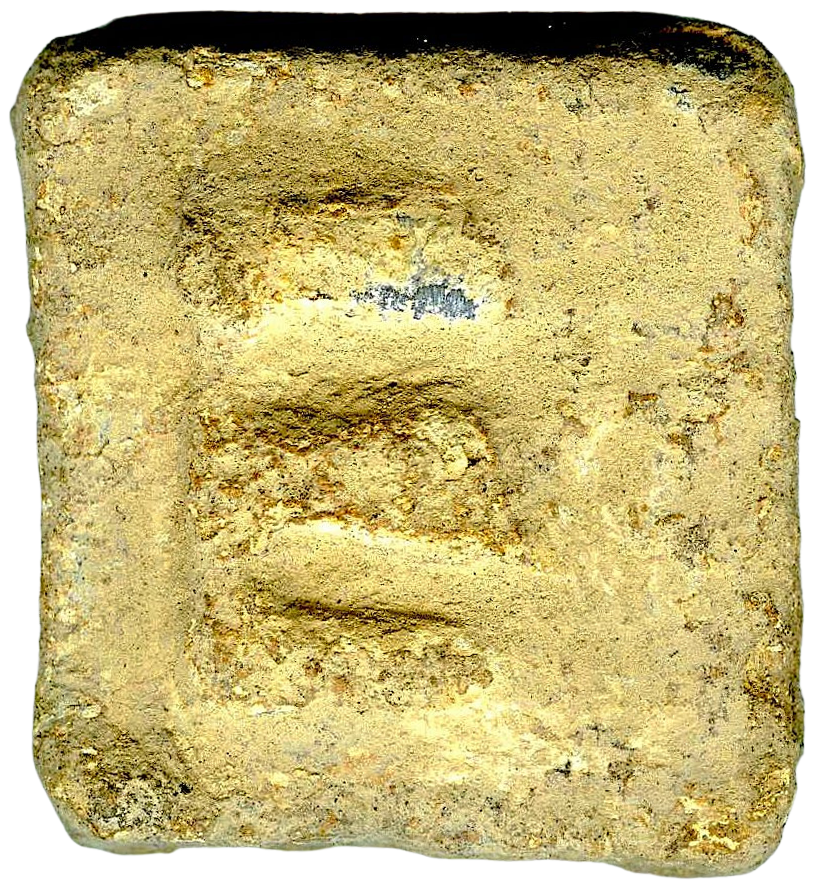
9) Inv. no. 2524
(fig. 9). Lead, 82.44 g, 40 x 35 x 9 mm. 1/6 mna (hektemorion,
mna of 494.64 g). Square in form with plain profile. On the top,
denominational mark E which stands for
ἕκτη,
in relief. The bottom is plain. It dates to the Hellenistic
period. Unpublished.
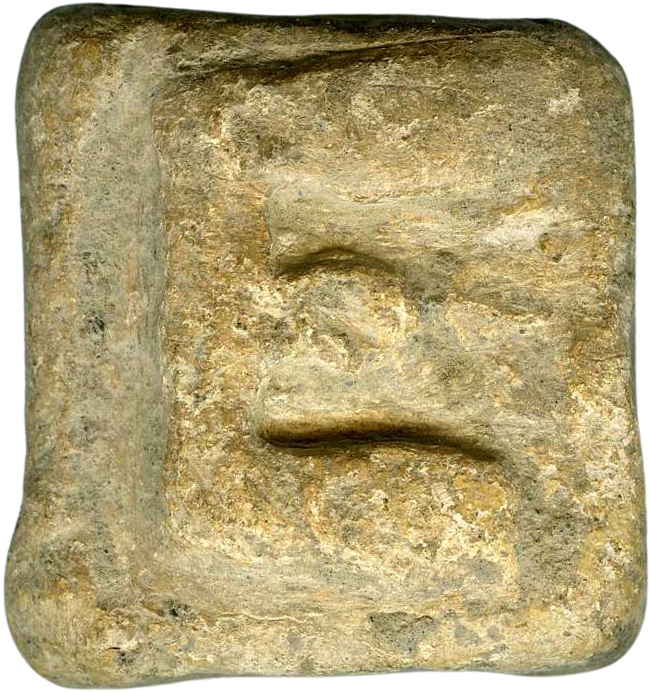
10) Inv. no. 2522 (fig.
10). Lead, 80.01 g, 27 x 28 x 10 mm. 1/6 mna (hektemorion,
mna of 480.06 g) Square in form with plain profile. On the top,
denominational mark E which stands for
ἕκτη,
in relief. The bottom is plain. It dates to the Hellenistic
period. Unpublished.

11) Inv. no.
1757 (fig. 11). Lead, 73.27 g, 40 x 41 x 5 mm. 1/6 or 1/8
mna. Square in form. Identical monogram within four circular
stamps:
![]() . The bottom is plain. It
dates to the Hellenistic period. Unpublished.
. The bottom is plain. It
dates to the Hellenistic period. Unpublished.
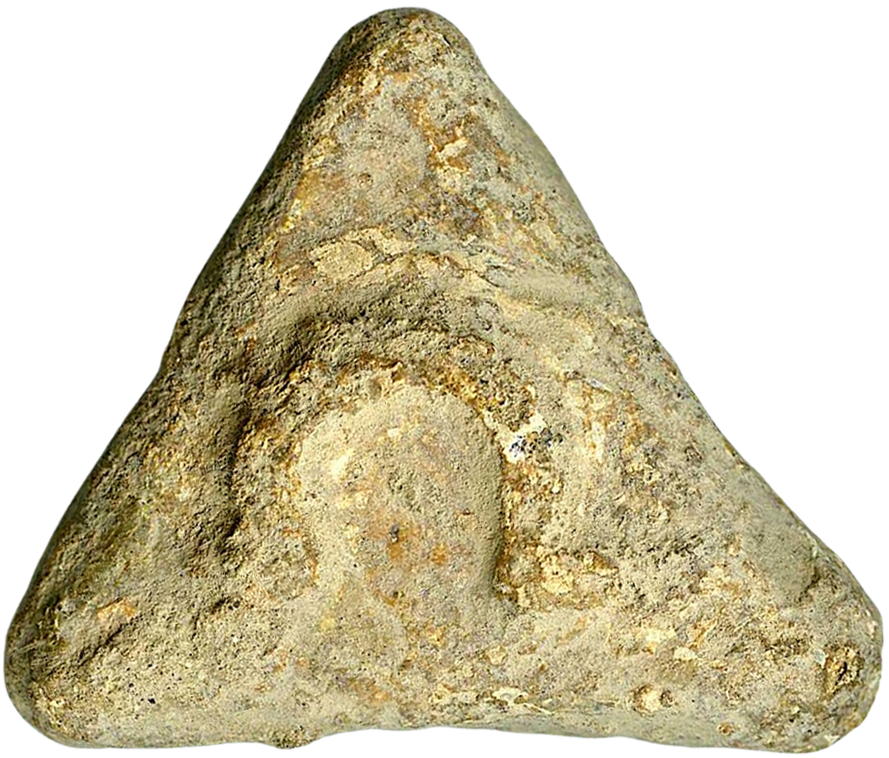
12) Inv. no.
2525 (fig. 12). Lead, 42.86 g, 37 x 36 x 38 mm.
1/12 mna
(dodekaton, mna of 514.32 g).
The triangular in form. On
the top, Ω in
relief. The triangular form resembles a Δ.
So, Δ and
Ω (ΔΩ)
refer to the Δωδέκατον in unit. The bottom is blank.
It dates to
the Hellenistic period. Unpublished.
Weights under the
Roman Empire and Byzantine Period


13) Inv. no. 1631 (fig. 13). Lead, 422.7
g, 70 x 69 mm (+ handle 20 mm).
Litra agoraia?
Square in
form with raised edges and handle above.
The inscription on the
top is illegible, but it is likely to be a word related to the
litra (ΛΙ/ΤΡΑ). There is a stamp on the handle but illegible. On the
bottom, illegible inscription in relief and in four lines: […]Α
/ [….] / […]A/ΓΟΡΑ
which gives the name of a certain
agoranomos.
It may be dated to the Early Roman Imperial
period. Unpublished.

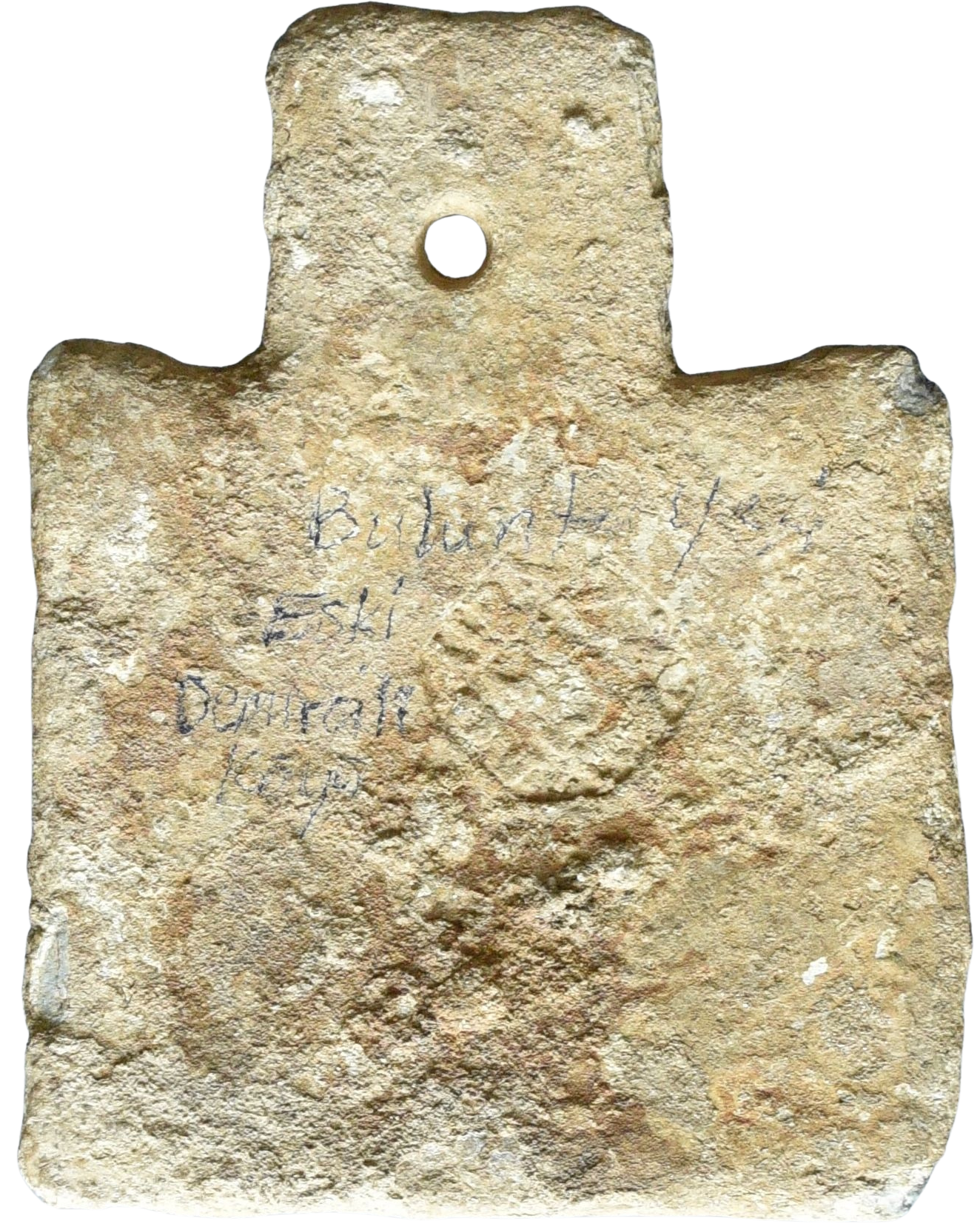
14) Inv. no. 1632 (fig. 14).
Lead, 420.7 g, 68 x 62 mm + handle 32 mm.
Litra agoraia.
Square in form with slightly raised edges and pierced handle on
the top. On the top, ΑΙ
/ ΒΑCΜΕΝΕΚ/ΡΑΤΟΥC
in relief and in three lines. The bottom is plain but
ΑΙ ΒΑ/C
ΜΕΝ/ΕΚΡΑ/ΤΟΥC
in square stamp. In other words, the same legend appears to be
repeated both on the top and within the stamp on the bottom:
Αἰ(λίου)
Βάσ(σου)
Μενεκράτους.
So, it gives a certain Menekrates who served as magistrate
responsible for issuing the weight.
It dates to the 2nd century AD. This weight was previously published by Laflı and
Buora[10];
however, the inscription was unfortunately misread as
ΛΙΤΡΑC /
ΜΕΝΕΚΡΑΤΟΥC and the
authors erroneously reported the weight of the object as 325
grams. Perhaps they assumed the object to be a litra and,
accordingly, expected its weight to conform to that standard or
they measured its weight incorrectly. However, the weight in
question corresponds not to the standard litra
italike, but
rather to the heavier market litra.
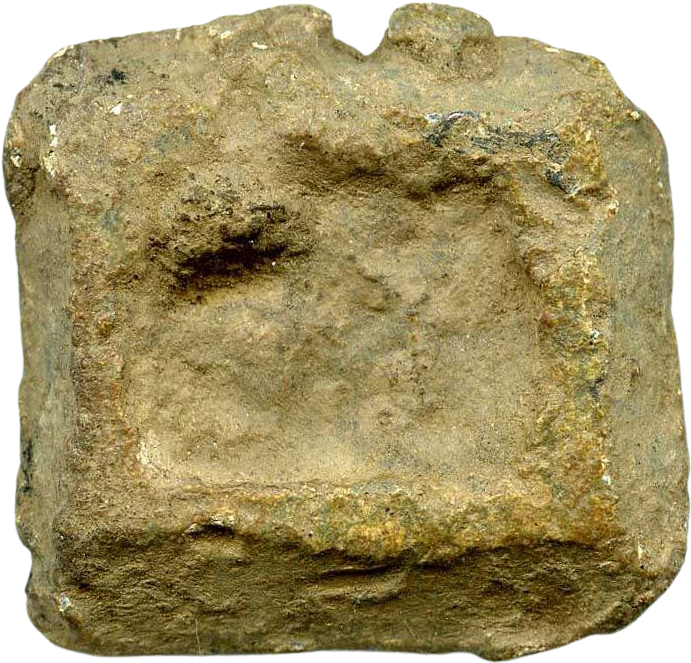
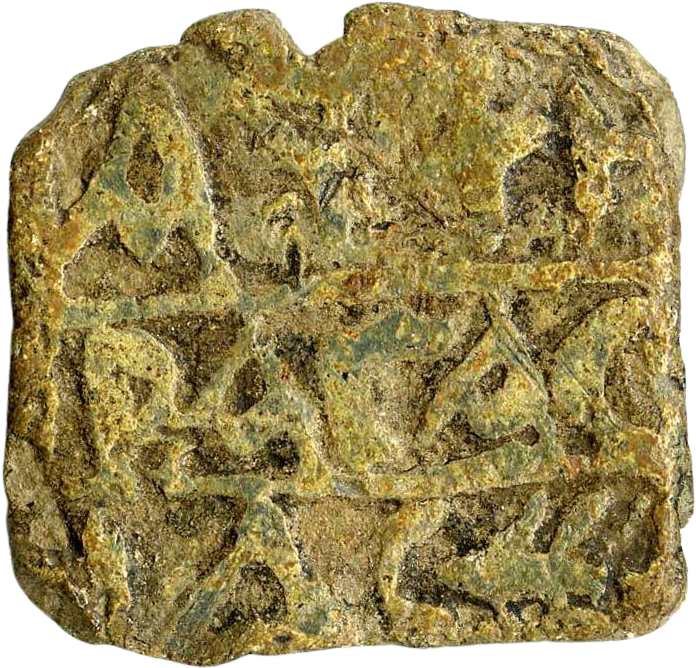
15) Inv. no.
2007-03 (fig. 15). Lead, 26.05 g, 28 x 30 mm.
One uncia.
Square with raised and beveled edges; handle is broken.
On the
top, A in relief. On the bottom, ΑΥΡΗ / [Β]ΑΓΑC
/ [.]AC[..] in three lines. It gives the name of a certain
Aurelios Bagas as magistrate.
It dates to the AD
2nd–3rd
centuries. Unpublished.
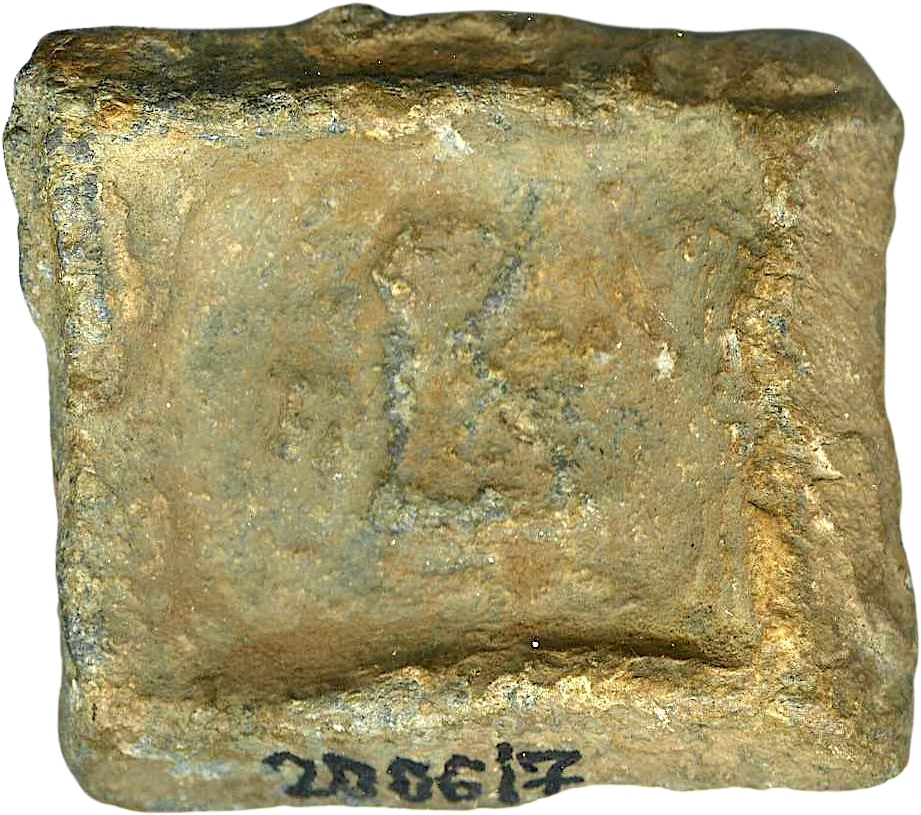
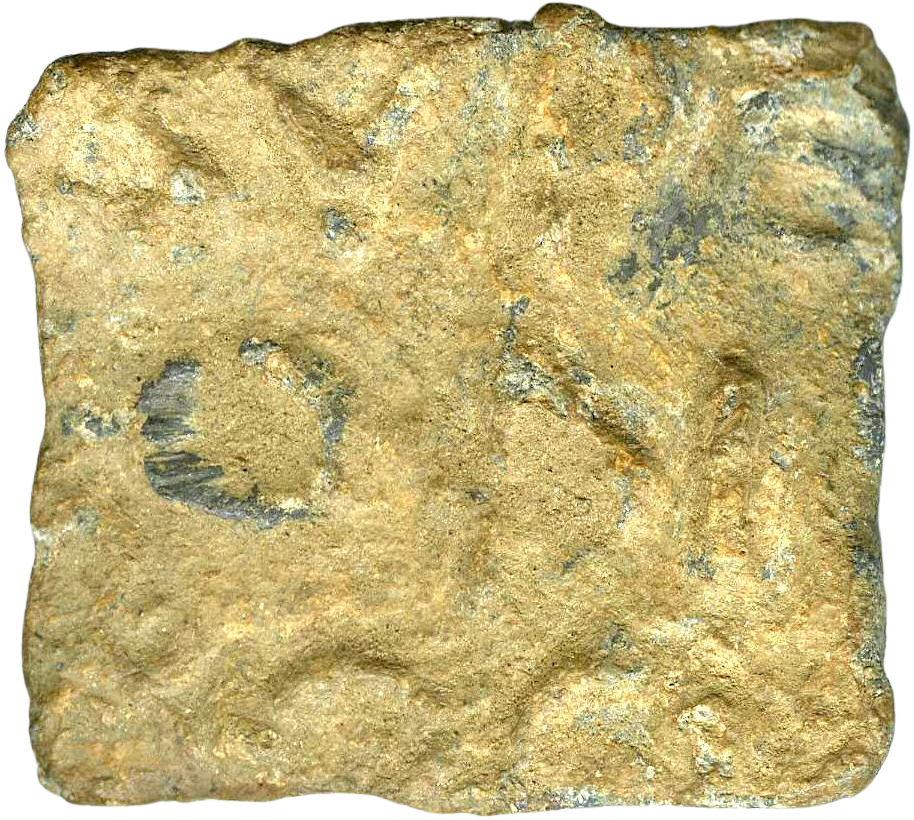
16) Inv. no.
2006-7 (fig. 16). Lead, 48.98 g, 34 x 39 x 10 mm.
Two
nomismata (nomisma of 24.49 g).
Square in form with raised
edges.
On the top, denominational mark B in relief. On the
bottom, illegible inscription in three lines.
It dates to the 2nd–3rd
centuries. Unpublished.
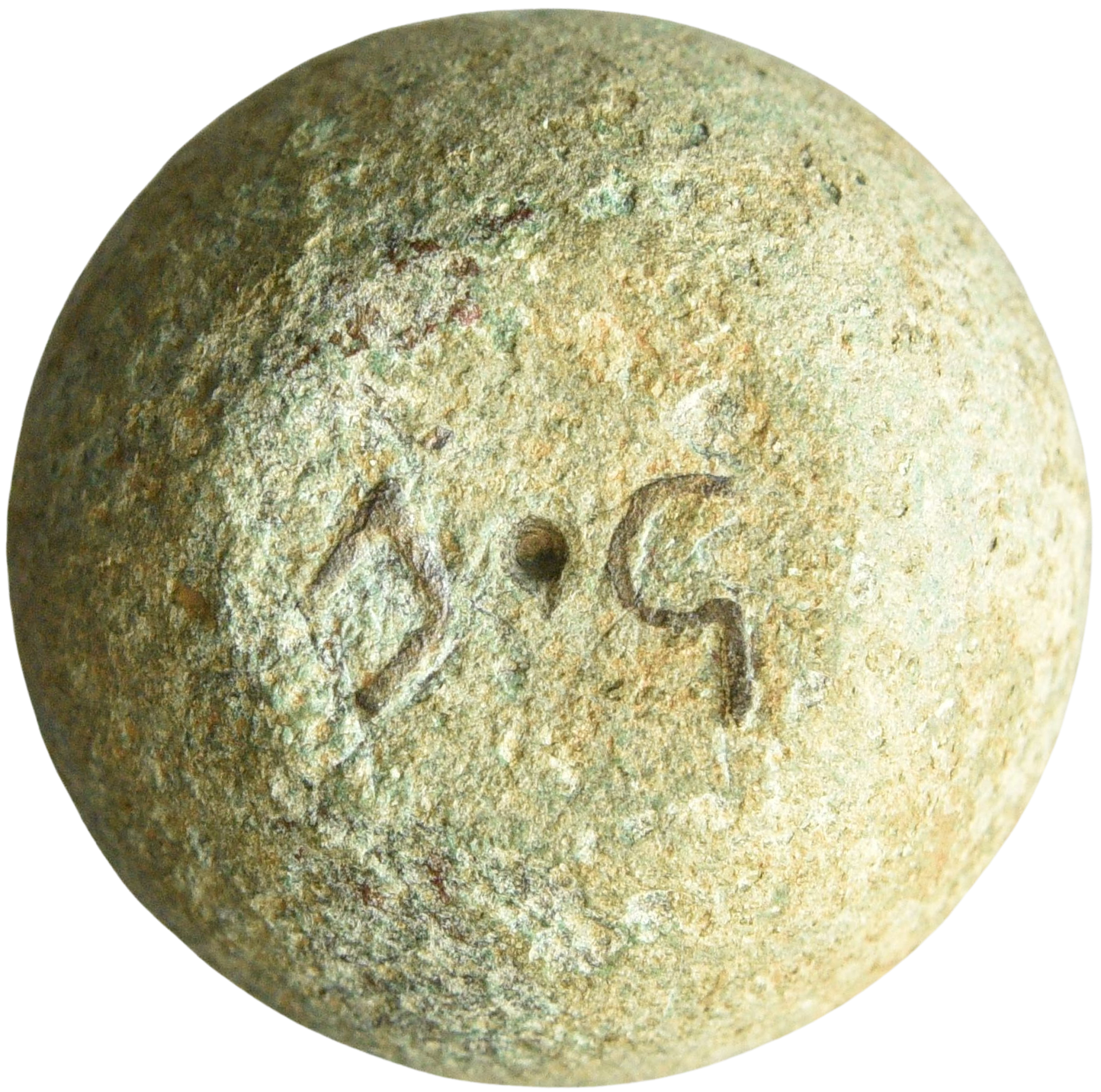
17) Inv. no. 2003-12 (fig. 17). AE 160.77
g, 33 x 27 mm.
Six unciae (uncia of 26.8 g).
Flattened sphere
doubly truncated in form.
Centring points on the top and bottom.
Silver-inlaid on the top with the denominational mark
ȣ ς.
The bottom is blank.
It dates to the AD 3rd–5th
centuries[11].
Unpublished.
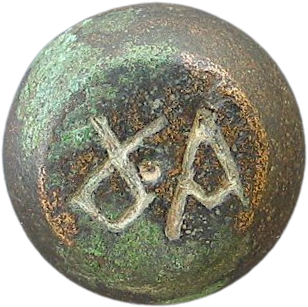
18) Inv. no. 2700 (fig. 18). AE 28.15 g,
19 x 14 mm.
One uncia.
Flattened sphere doubly truncated in
form.
Centring points on the top and bottom. Silver-inlaid on
the top with the denominational mark
ȣ
A. The bottom is blank.
It dates
to the AD 3rd–5th centuries[12].
Unpublished.

19) Inv. no.
2217 (fig. 19). AE 78.92 g, 34 x 33 x 9 mm.
Three unciae
(uncia of 26.30 g).
Square in form with slightly beveled edges.
On the top, engraved and punched with the denominational mark
Γo
Γ which stands for
three unciae and cross above. The bottom is blank.
It dates to
the AD 5th–6th
centuries.
Unpublished.

20) Inv. no.
1045 (fig. 20). AE 23.8 g, 29 x 28 mm.
One uncia.
Square
in form with plain profile.
On the top, engraved with a large
cross flanked by the denominational mark
Γ Α. Originally inlaid but inlay is
missing. The bottom is plain.
It dates to the AD 5th–7th
centuries. Unpublished.
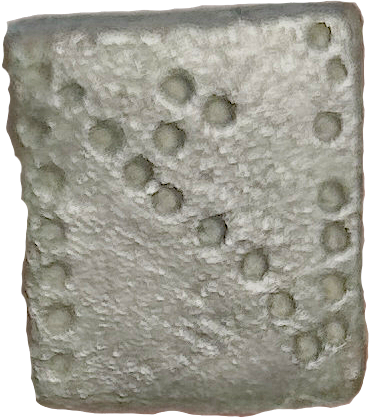
21)
Inv. no. 2214 (fig. 21). AE 4.17 g, 14
x 12 x 4 mm.
One nomisma.
Square in form.
On the top, punched
with the denominational mark N with three-dot motif (o) between
legs[13].
The bottom is plain.
It dates to the AD 4th–7th
centuries. Unpublished.
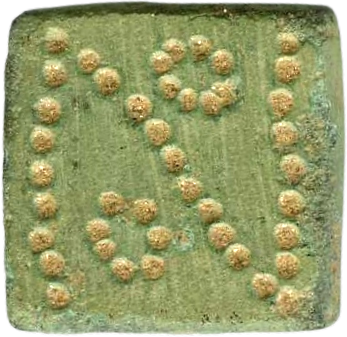
22) Inv. no. 2117 (fig. 22). AE 3.95 g, 14
x 14 x 3 mm.
One nomisma.
Square in form.
On the top, punched
with the denominational mark N with o between each of the legs
of the N. The bottom is plain.
It dates to the AD
4th–7th
centuries. Unpublished.
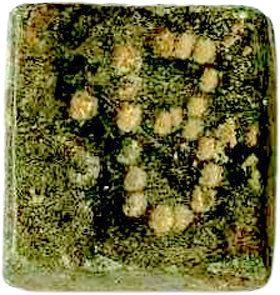
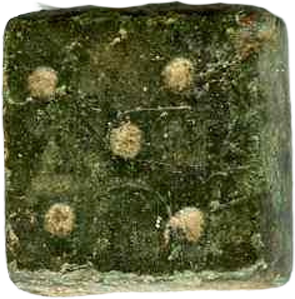
23) Inv. no. 2215 (fig. 23). AE 2.12 g,
9.5 x 1.00 x 3 mm.
Twelve keratia (keration of 0.17 g).
Square
in form.
On the top, punched I B; on the bottom, a
motif of five punched
dots[14].
It dates to the AD 5th–7th
centuries. Unpublished.
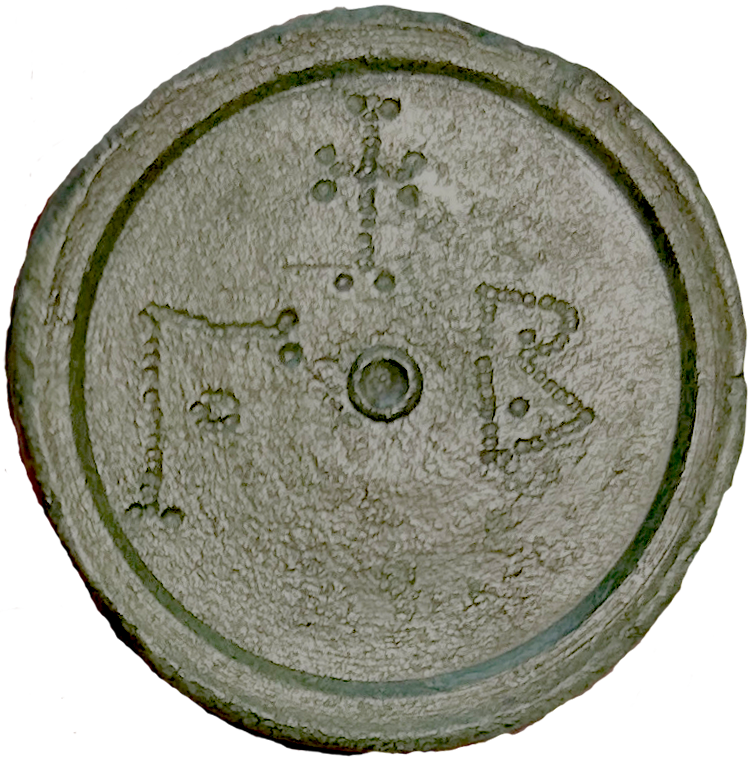
24) Inv.
1648 (fig. 24). AE 51.70 g, 36 x 8 mm.
Two unciae (uncia of 25.85 g).
Discoid in
form with double convex grooved profile; with raised rim and
groove along the rim and centring points on the top and bottom.
Punched on the top with the denominational mark
Γo
Β; above, cross. The
bottom is plain but an X-shaped scratch.
It dates to the AD
5th–7th centuries. Unpublished.
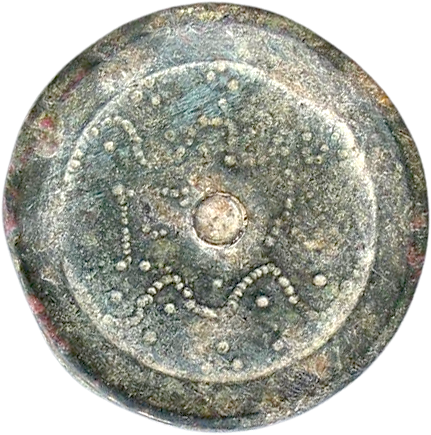
25) Inv.
2055 (fig. 25). AE 27.08 g, 27 x 7 mm.
One uncia.
Discoid in form with double convex
grooved profile; with raised rim and groove along the rim and
centring points on the top and bottom.
On the top, punched with
the denominational mark Go A;
wave motif above and below. Single and triple dot motifs in the
field. The bottom is plain.
It dates to the AD
5th–7th
centuries. Unpublished.
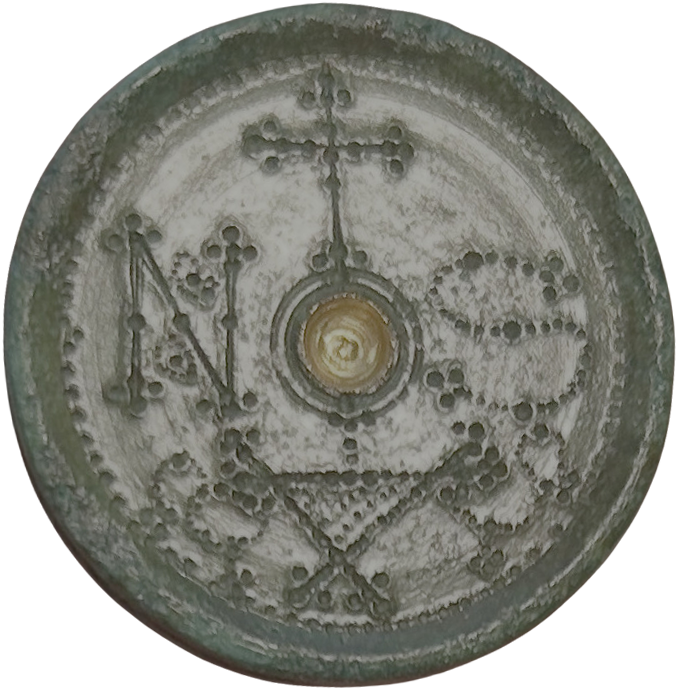
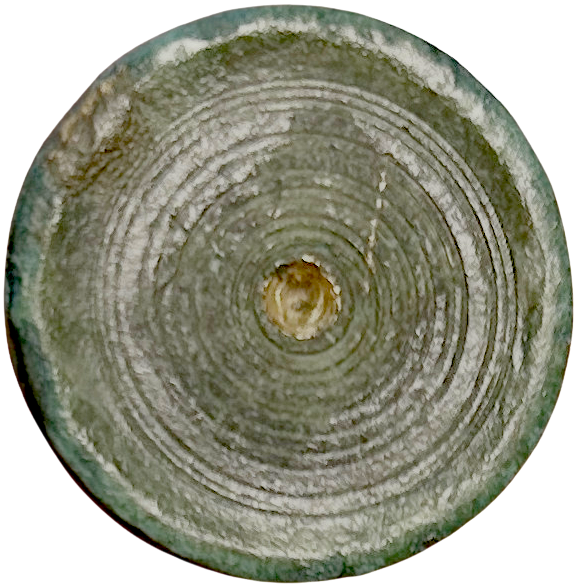
26) Inv. no. 2007-10-A (fig. 26). AE 26.30
g, 27 x 16 mm.
Six nomismata (nomisma of 4.38 g).
Discoid in
form with double convex grooved profile; with raised rim and
groove along the rim and centring points on the top and bottom.
On the top, engraved and punched with the denominational mark N
S; above, cross; below, triangular shape. On the bottom,
concentric circles extend from the center to the edges.
It dates to the AD 5th–7th
centuries. Unpublished.

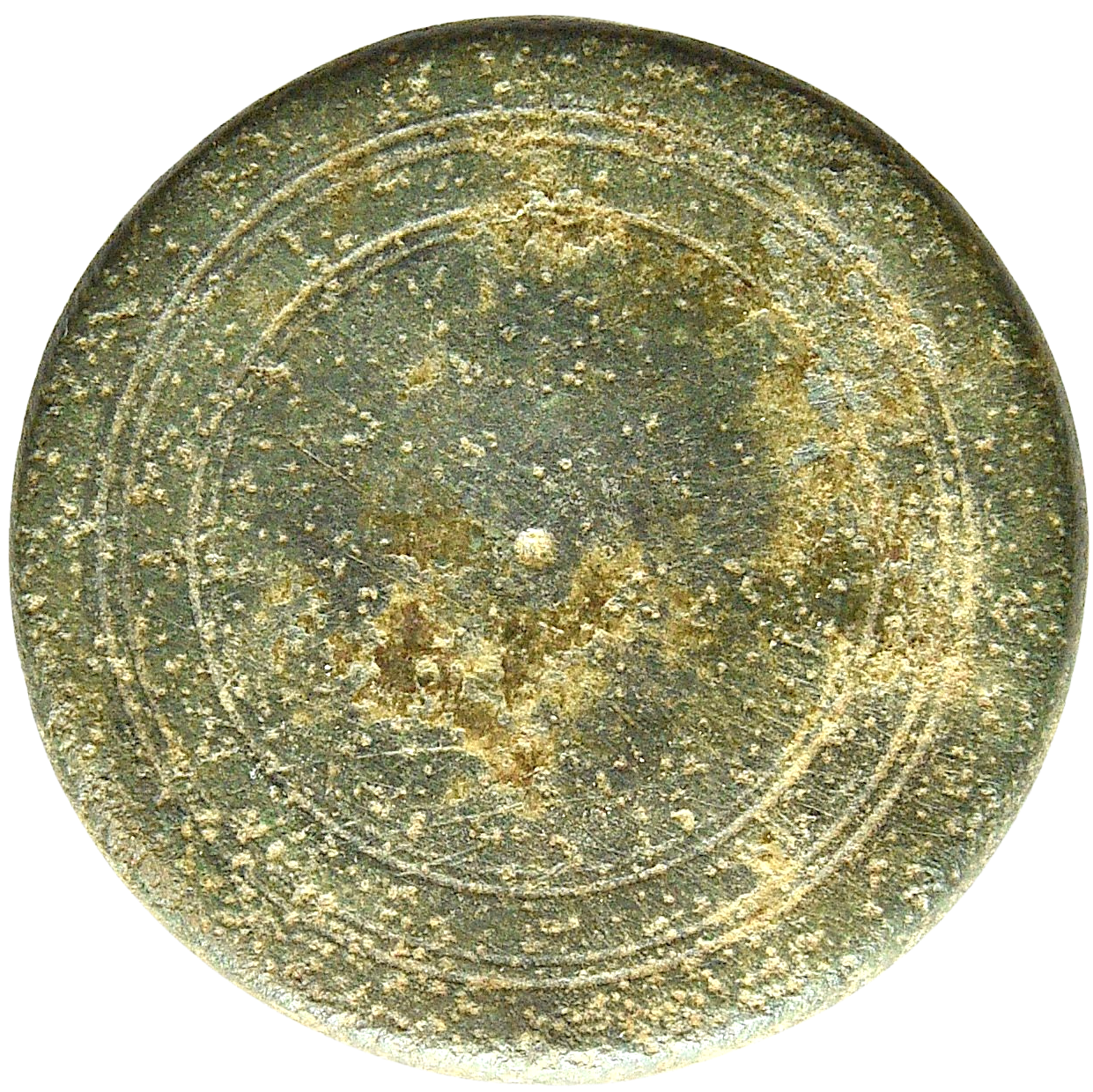
27) Inv. no.
2411 (fig. 27). AE 25.75 g, 30 x 9 mm.
Six nomismata
(nomisma of 4.29 g).
Discoid in form with slightly raised rim
and plain profile; centring point on the top and bottom; too
worn.
On the top, engraved and punched with denominational mark
N S. Concentric circles near the edge on the bottom.
It dates to the AD 4th–6th
centuries. Unpublished.
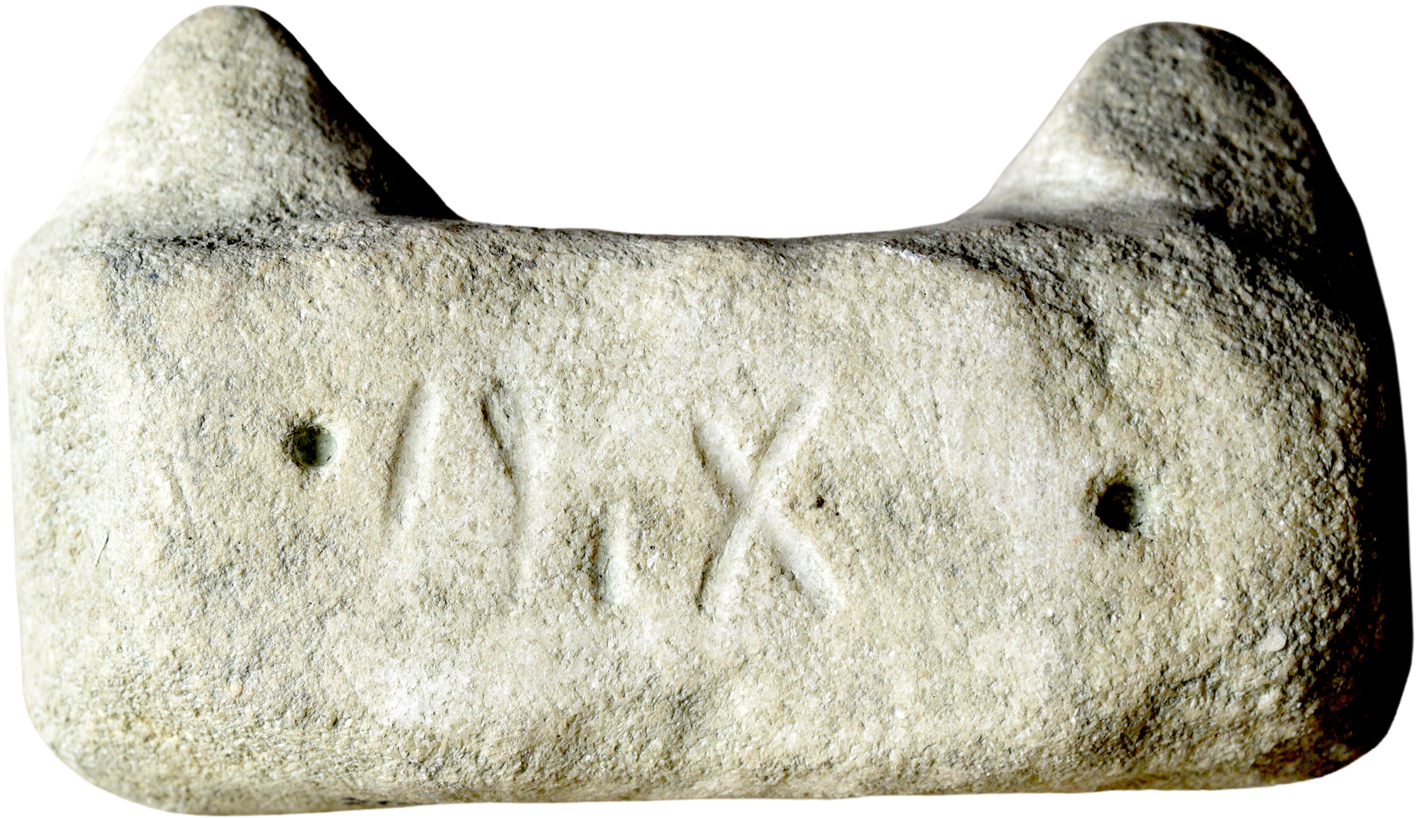
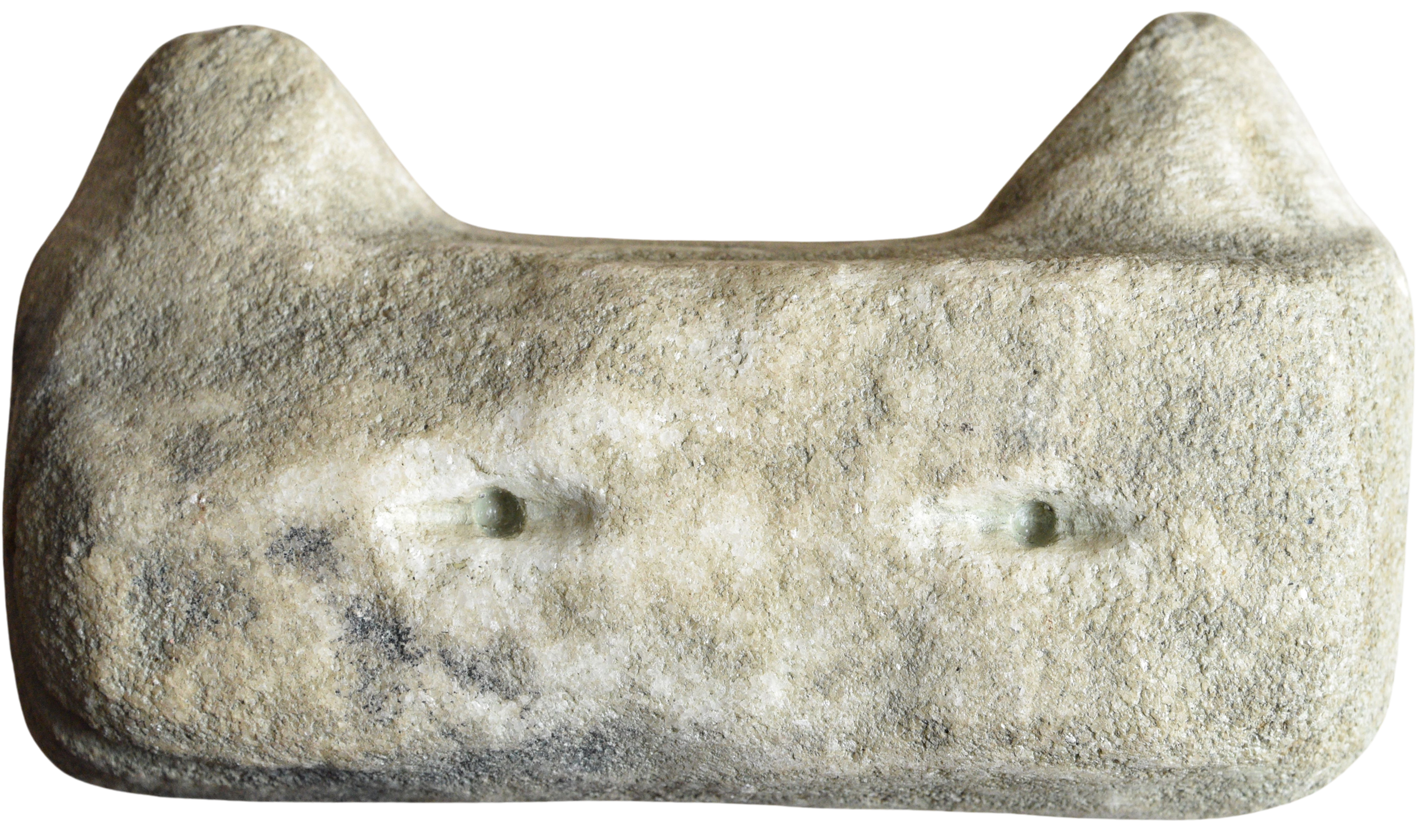
28)
Inv. no. 2006-14 (fig. 28).
Limestone, 1831.8 g, 16 x 6.6 cm (plus 7.5 mm high of
dome-shaped protrusions).
5.5 librae? (libra of 333.05 g).
Mastoid in form[15].
On one of the profile faces, there are two slanted
lines placed side by side (two upright
scratches) and an X.
It dates to the 1st century BC –
early Roman Imperial period. Unpublished.
[1]
I would like to thank Museum Director
Feride Kat for granting me permission to study the
weights in the collection, and museum specialist Ayşen
Coşkuntuna Gürsel for her assistance throughout my work.
I am also grateful to Hüseyin Sami Öztürk for sharing
his insights on several of the weights.
[2] For
the Colophonian weights see Tekin
2016, 111–113. Also, Pondera, »Colophon«:
pondera.uclouvain.be/
[3] As
for the dating; since weights continued to be used for
long periods after their production – as long as the
standards did not change – it is very difficult to date
them precisely. Therefore, a more flexible dating is
usually applied, based on parameters such as parasemon,
ethnic, unit name, variations in weight within the same
unit, or form. This approach typically favors broader
chronological categories, such as the Hellenistic
Period, Roman Imperial Period, or Early Byzantine
Period. More precise dating may become possible only
when the number of weights recovered from stratified
archaeological contexts increases. For now, however, we
are compelled to adopt a more relative and tentative
dating method. As for the identification of the units,
determining the unit of a weight is relatively easy when
a unit mark is inscribed, as such marks are typically
verified by checking the object's mass against the
expected standard. For weights lacking such unit marks,
the unit is suggested based on how closely the weight
aligns with a recognized system and its standards.
[4] A few
remarks can be made regarding the arrangement of the
weights. The
sequence begins with those dated to the Hellenistic
period, namely nos. 1–12. These are organized
internally according to their units, from the largest to
the smallest. However, the first two weights (nos. 1
and 2) are placed at the very beginning of the
entire sequence because they are attributed to the city
of Colophon based on the parasemon they bear. Since
their attribution is certain, they are prioritized. The
remaining Hellenistic weights lack any parasemon or
ethnic identification,
making it impossible to attribute
them to any specific city. They are therefore arranged
solely by their units (and naturally their weights),
from largest to smallest. In other words, they are all
essentially anonymous weights, used in the marketplace
but without any indication of which city’s market. They
bear only unit marks – or sometimes not even that –
though their unit can usually be estimated based on
their actual weight. Thus, except for the first two, the
weights in the Hellenistic group are ordered by unit.
The section titled »Weights Under the Roman Empire and
Byzantine« follows the same logic – weights are grouped
according to their units. However, an additional
criterion is also applied here: form. Weights of similar
forms are grouped together: for example, barrel-shaped,
discoid, or square ones. This is because form can
sometimes be significant for chronological or
comparative purposes. Placing a barrel-shaped example at
the beginning and another of the same form at the very
end – just because their units differ – would have been
less appropriate. This may also be seen as a matter of
preference. The
mastoid weight (no. 28) is listed last, not
because it is the heaviest, but because its shape and
possibly its function differ from the others.
[5] Tekin
2016, Table 41, no. 2, fig. 227 = Pondera 13283:
pondera.uclouvain.be/artifact/13283/.
[6]
Tekin 2016, Table 41, no. 13 = Pondera,
13294:
pondera.uclouvain.be/artifact/13294/.
[7]
For a weight with a similar form and decoration but
bearing a different magistrate’s name (Menekrates), see.
Pondera, 16393:
pondera.uclouvain.be/artifact/16393/
[8]
It is difficult to say anything definite about the full
form of the name here. The name Pandokos is attested in
epigraphic sources from the Thessaly region (e.g. SEG
51, 711), but in this case, we can only speak of a
similarity in names; anything beyond that does not seem
possible. Moreover, we know that in the case of weights,
individuals responsible for market supervision did not
always hold the title of agoranomos; people
from other official posts could also assume this role.
Therefore, it would not be appropriate to draw any
conclusions about the specific office in this context.
[9] Buora
– Laflı 2021, 240 f. no. 5.
[10]
Buora – Laflı 2021, 239 f. no. 4.
[11]
For similar ones see CPAI 3/2, nos. 6–11
(= Pondera 18317, 18321, 18386 respectively:
pondera.uclouvain.be/artifact/18317/;
pondera.uclouvain.be/artifact/18321/;
pondera.uclouvain.be/artifact/18386/
[12]
For similar ones see CPAI 3/2, nos.
31–40.
[13]
For punched one-nomisma weights see CPAI
3/2, nos. 417 ff.
[14]
For punched twelve-keratia weights with
five-dot motif on the bottom see CPAI 3/2, nos. 516 and
519.
[15]
For mastoid weights and their function
see Güler 2023; Kroll - Stefanaki 2020; Ersoy 2018.